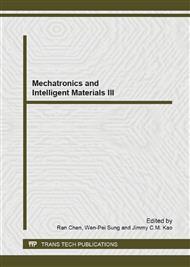p.1278
p.1282
p.1286
p.1290
p.1294
p.1300
p.1305
p.1310
p.1314
Dynamic Modelling and Simulation of Electromechanical Systems Based on Vector Bond Graph
Abstract:
For the dynamic modelling and simulation of electromechanical coupling systems, the corresponding vector bond graph procedure is proposed. Based on the kinematic constraint relations of rigid body, the vector bond graph procedure for modelling spacial multibody systems with revolute joint is described. For the difficulties brought by differential causality in the system automatic modeling and simulation, the effective decoupling method is proposed. As a result, the unified modelling and simulation for electromechanical systems are realized, its validity is illustrated by the robot system driven by electrical motors.
Info:
Periodical:
Pages:
1294-1299
Citation:
Online since:
June 2013
Authors:
Price:
Сopyright:
© 2013 Trans Tech Publications Ltd. All Rights Reserved
Share:
Citation:


